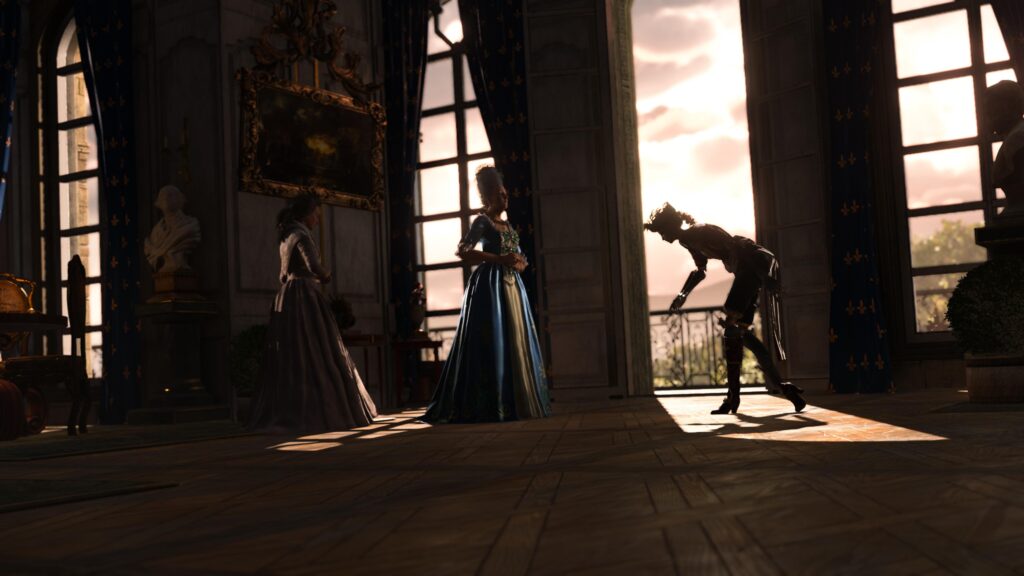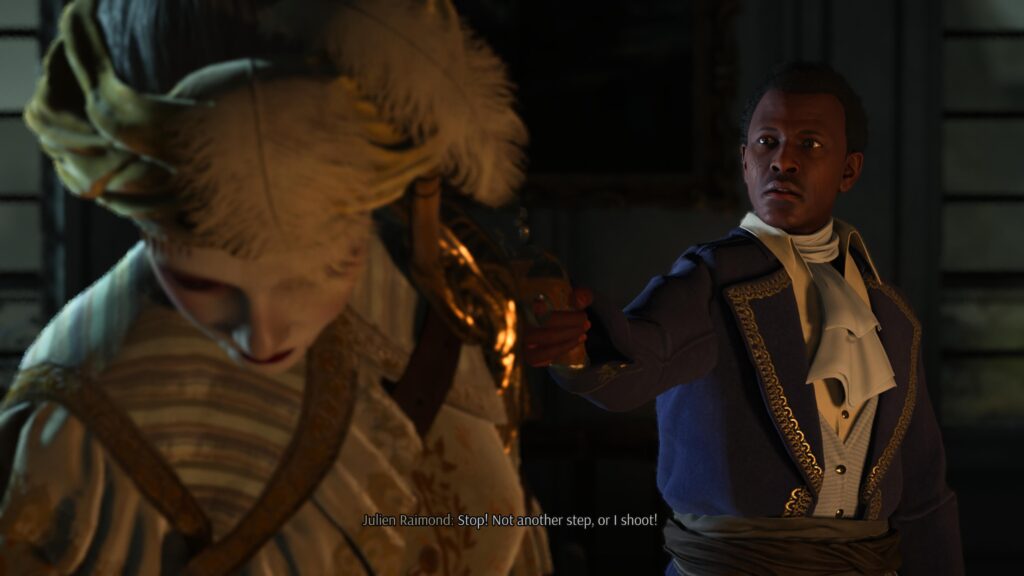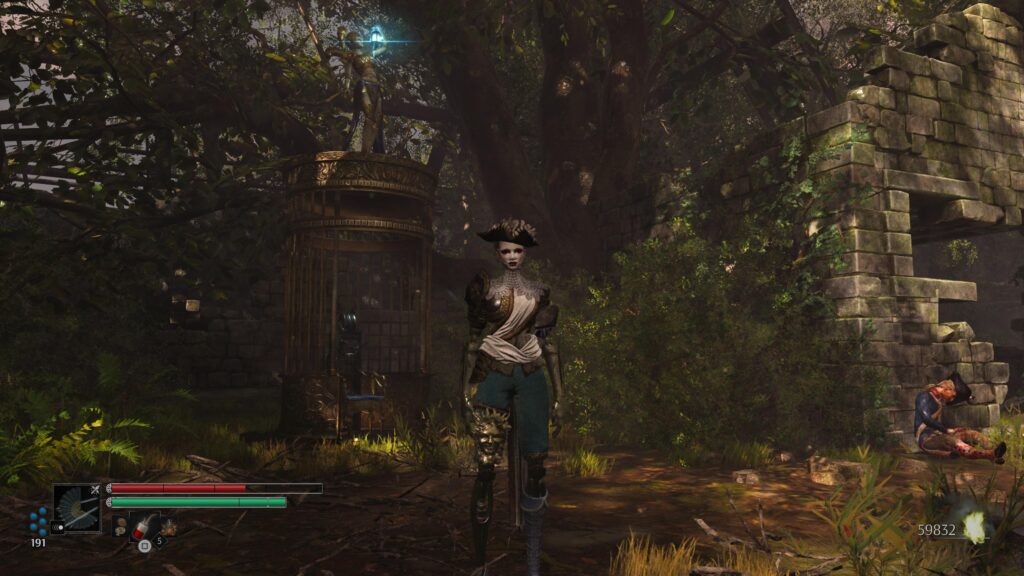It is the late 18th century. The Marquis de la Fayette has returned to France after helping the Americans win their country, and now it is time to free his own country from Louis XVI, the Clockwork King, who has constructed a mechanical army to terrorize Paris.
You play as Aegis, an automaton sworn to do the bidding of the Mad King’s queen, Marie Antoinette, who is trying to escape with her children back to her native Austria. Unlike all other automatons, you can talk and think and, through the course of the game, will come to know all the other players of the French Revolution, and the secrets of your own dark origin.
Given the fantastical plot, the game manages to pack in quite a lot of information about the people and motivations behind the French Revolution. Robespierre, Marat, la Fayette, Julien Raimond, Mirabeau and others appear, often after you have saved them from unspeakable fates, and talk about what drove them to rebellion. Raimond, a Black plantation from Saint-Domingue, who would later go on to lead the Haitian Revolution, has a particularly intricate story.
As a game that instructs about the French Revolution and tours some of the most famous Paris locations of the day — St. Cloud, Versailles, the Louvre, the Bastille and others — the game is a clear success. But how is it as a game?
The Souls are called Anima
Steelrising is a strange hybrid of a Dark Souls-like game and a Castlevania-type game. There’s only a limited number of locations to visit in Paris, but each time you gain a new ability, there will be more places you can explore in those locations. You will be returning to all of the districts many times. This lead me, when I played, to a lot of wasted time trying to figure out how to get to places where I could see some treasure. Was I not able to go there at all because I didn’t have the right ability yet, or was I missing a secret passage that led there, or was I just not good enough at platforming to make it there? All these things were true at times.
Your choice of four classes at the start of the game determines your starting weapons (of which there are seven broad categories), as well as your starting stats. As in other games of this type, there’s nothing stopping you from continuing to build your character as you like. I started with the Dancer class, which starts with kung fu metal fans. I stayed with the starter weapon until I found an upgrade I liked, and then used that upgrade for the rest of the game. And even then, the starter weapon was in some ways better than the upgrade I chose.
Killing enemies earns you anima, the currency that is spent to upgrade weapons and stats. If you die, your anima is dropped where you died and you respawn at the most recent “vestal” you interacted with. Vestals are metal cages where you can upgrade your stats, weapons and modules as well. Unlike the various save points in the two “souls-like” games I have played, Bloodborne and Elden Ring, you cannot teleport among the vestals, and so there is quite a lot of running and re-fighting all the enemies you’ve been fighting again.
Enemies also drop various useful items like various elemental grenades, potions to protect against elemental effects, heal-over-time phials and most importantly, alchemical charges.
The Power of Alchemy
All weapons have a basic, quick attack, a longer, chargeable heavy attack, and a special attack. My starting dancer fan had a special attack of “Shield”, which would defend against any attack at the cost of Endurance, but was too slow to be really useful. I replaced it with a fan that could shoot out double knives that had a good chance to build up an enemy’s immobilization meter while I closed the distance.
This attack took alchemical charges. You’ll find yourself running out of this resource if you use it too heavily, unless you boost your item find percentage while you level up.
I had over 600 alchemical charges saved up before I went into the endgame. By the time I finished, I was down to about 200. The urge to use the special attacks to make garden variety fights trivial is pretty strong.
You will be able to swap between two weapons at will. I used a different weapon — a fire chain — to set the burning condition before moving in with the fans. Other weapons can apply frost conditions or fulmination (lightning) conditions. There is no bleed condition as all your opponents are automatons — no blood.
The Enemies
King Louis XVI’s paranoia has grown to such an extent that he finds he cannot trust his closest counselors and confidantes. Taking the flimsiest pretexts to imprison them, he finds his only friend to be the mysterious Count de Cagliostro, an Italian mesmerist who uses the powers he learned from German astronomer Franz Mezmer to occultly animate the automatons created by the legendary inventor Vaucanson, consigned to the Bastille after the creation of his finest automaton — Aegis, the one you play.
But Cagliostro is playing with powers he does not understand, powers that require the draining of human souls, which puts him in conflict with the Church. But he has found a seeming limitless source of souls, and for the seven major bosses in the game, the most special souls of all.
Enemies have health and can obtain buffs and suffer ailments. They also have an “immobilization” meter. This is filled up when Aegis attacks them. Different weapons can increase immobilization by different amounts, and certain stats affect this as well. Once the meter is maxed, the enemy stumbles and is susceptible to critical attacks that can take a huge chunk off their health bar, or to give Aegis a moment to heal up, reposition, or charge up a strong attack.
Enemies also are not immune to friendly fire, so a valid strategy in fights versus multiple enemies is to just move around and dodge so that they attack themselves.
Moves are usually pretty well telegraphed and are not that hard to dodge. Dodging and attacking uses up endurance, though, and if you run out of endurance, you will find yourself helpless and open to critical attacks. Some enemy attacks also drain endurance. Luckily, it refreshes fairly quickly when you stop attacking. It can also be quickly refreshed, at the cost of some health, and a phial can give it a boost.
Assist Mode
Unlike the other Souls-likes I’ve played, Steelrising comes with an “assist mode”, that you can turn on and off at will. You can set it to take less damage (up to and including taking no damage at all), regaining endurance more quickly, and keeping your anima when you die. Using all of these together would make the game trivial. Using none of them means a lot of the trash fights will wear through your healing items fairly quickly, as there’s far fewer rechargeable healing potions per visit to a vestal then in Elden Ring.
Using assist mode will block you from earning certain combat-focused trophies on the PlayStation 5 version, though the plot-related trophies will still be earned.
I went with 25% less damage when I had trouble with the first boss. I eventually set it to 75% and toward the end, 100% less damage as I got eager to get to the end. There’s plenty of platforming and other puzzles and I didn’t feel like I was getting any fun out of the endless trash fights. Not apologizing, but in the New Game Plus run I started, I am not using assist mode AND am trying for the trophy of never using the healing flask (the slower heal over time phials are still okay, and I have a module that heals on crits).
The Environment
Elden Ring had a really open environment that allowed you to skip straight through areas in creative ways. Steelrising is filled with invisible walls and jumps you just can’t quite make. It appears to be open, but it is actually incredibly linear. You will go here, here and here, and in this order. Since so much of the game is revisiting old areas that have just opened new paths, the game doesn’t want you skipping ahead.
Paris has been emptied of almost every living human, though there are plenty of dead around. The entire city is in ruins, which made me wonder a bit where the leaders of the revolution were going to find their armies. Some people are still in the city, though you will never see them. As in Bloodborne, you can talk to them through the door of their home, and they can offer information or the occasional side quest.
Ruined Paris has the strongest doors. Even a super automaton such as yourself can’t knock down the flimsiest of them. And so the buildings of Paris are mazes. The rare dungeons are themselves part of the larger world, and tend to be very small. The largest of which, the Bastille itself, comes only at the end of the game.
So, was it worth playing?
I found the endless trash fights tedious. They were necessary, to earn anima, but I once I removed damage and the game became more about the puzzle solving, platforming and the story itself, I enjoyed it much more.
I did enjoy the plot. I liked talking with the leaders of the revolution and finding out what I assume to be factual information about their roles in the revolution and their larger goals. I was able to thank la Fayette for his role in the American War of Independence, although I was influenced by a pamphleteer to make an unjust accusation against him.
The story of the rise of the Automatons and Aegis’ own very tragic history — loved it.
Steelrising didn’t need to be a souls-like. I fully enjoyed Spiders’ previous hit, Greedfall, a more standard RPG, and would very much have liked to have seen Steelrising follow along with that.
I mentioned that I didn’t change weapons very often. Part of that is that it is very expensive to level up weapons, and the weapons themselves hit different stats, also a huge expense to level. Elden Ring made it easy to level up all weapon types to at least a useful level, while reserving the ultimate upgrades to only a few, favorite weapons. My Dancer started with a bonus in Agility, and I stayed with agility weapons for most of the game, with the secondary weapon being used only to apply status conditions.
It was fun enough. I bought the DLC for the extra quest with Cagliostro. I think that’s where I got the fan upgrade. I did pay the full price, but as far as Souls-like games go, I don’t think experience souls-players would find this game much of a challenge and might want to wait for a sale. The constant returning to already visited areas in particular seems very unsouls-like.








